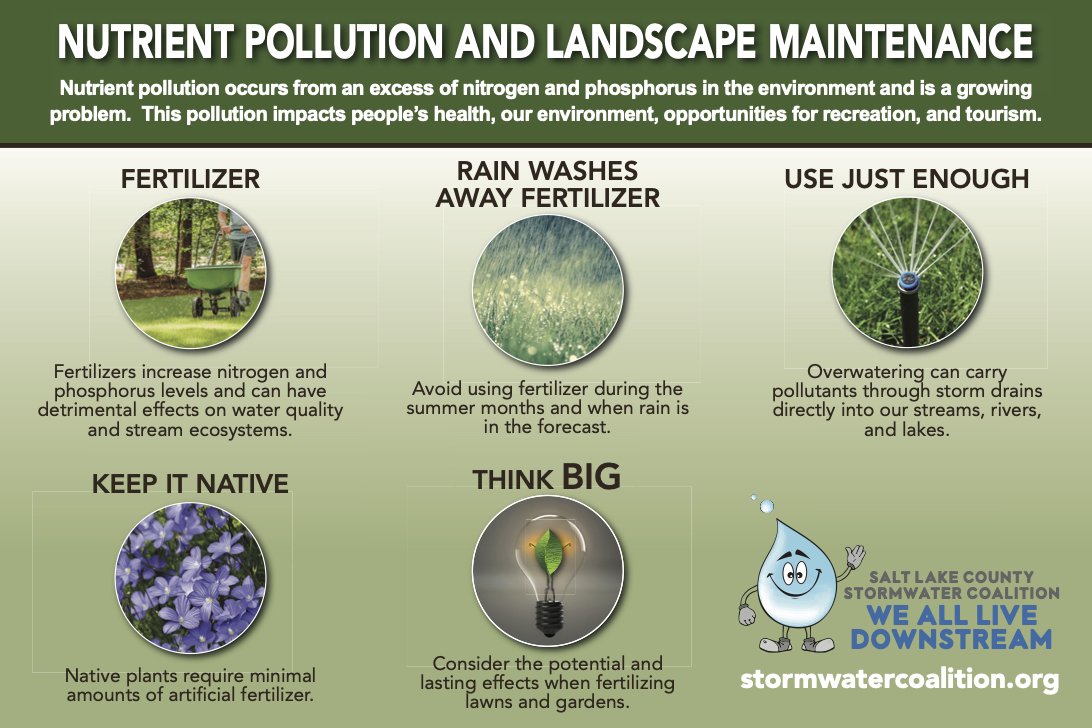Institutions, Industrial and Commercial Facilities
Stormwater Management Where it Counts.
WaterSense at Work-Best Management Practices for Commercial and Institutional Facilities (EPA)
Site Design and Stormwater Management Integration (Philadelphia example)
Develop An Illicit Discharge Detection and Elimination Program
Develop An Illicit Discharge Detection and Elimination Program- Guidance Manual (EPA)
Industrial activities and storage and handling of materials at commercial and industrial facilities have the potential to pollute stormwater runoff with sediment, chemicals, oil and grease, metals, and trash. Stormwater runoff can pick up these items, thereby contaminating the storm water. It carries the pollutants right into the storm drains, which flow directly into our streams, rivers and lakes.
Best Management Practices (BNPs), simple and effective methods to prevent the pollution of stormwater, should be implemented by commercial and industrial facilities
to prevent pollutants from being picked up by stormwater. Implementing stormwater BmPs is a vital part of protecting Salt Lake County waterways.
Stormwater Practices for Institutions, Industrial and Commercial facilities:
1.Significantly reduce water waste through water-efficient fixtures, technologies and techniques by adopting “WaterSense” practices, such as assessing water-intensive equipment for proper operation and efficiency can help to eliminate water waste. https://www.epa.gov/watersense/best-management-practices
2. Develop An Illicit Discharge Detection and Elimination Program that features both responsive and pro-active approaches to IDDE incidents, that addresses comprehensive sources including dry-weather flows, sanitary wastewater or industrial and commercial pollutant entries, failing septic tank systems, vehicle maintenance activities, and others as applicable.
3.Create a company/institutional culture of environmental awareness and stewardship,such as sustainability offices and initiatives on college and corporate campuses; encouraging and incentivizing the development of clubs, volunteer opportunities, community events, etc.; promote and adopt company-wide behaviors through physical/structural, such as company-wide HHW bins, additional trash bins where litter has been a problem, and pet waste bag stations in appropriate locations.
Institutions:
Colleges and Universities
Stormsmart Schools (EPA)
Linking stormwater best management practices to social factors (scholarly article- NIH)
Campus Water Quality (UNC example)
Hospital Stormwater Management Plan Examples:
Veterans Hospital (SLC)
Industrial:
If industrial materials and operations are not exposed to stormwater there may be the opportunity to be excluded from NPDES industrial stormwater permit requirements. —No exposure certification (EPA)
CoMmercial Facilities:
Commercial Car Washes
From EPA: Stormwater Tip Sheets for Business
Stormwater Tip Sheet for Business: Auto Shops (September 2022) (customizable) (pptx)(423.24 KB)
Stormwater Tip Sheet for Business: Auto Shops (September 2022) (pdf) (472.78 KB)
Stormwater Tip Sheet for Business: Construction Crews (September 2022) (customizable) (pptx) (512.47 KB)
Stormwater Tip Sheet for Business: Construction Crews (September 2022) (pdf) (4.11 MB)
Stormwater Tip Sheet for Business: Restaurants (September 2022) (customizable) (pptx)(421.37 KB)
Stormwater Tip Sheet for Business: Restaurants (September 2022) (pdf) (603.68 KB)
Stormwater Pollution Prevention Matters for Your Business (Ontario example)
Topic Specific Resources
Proper lawn maintenance (use of pesticides, herbicides and fertilizer)
Resource Examples
Lawn & Garden Tips to Curb Stormwater Pollution (Spencer, MA)
Stormwater Friendly Lawn & Garden Care (Alliance for the Bay)
Design Your Landscaping to Handle Stormwater Runoff (Earth911)
Proper Maintenance Practices for Your Businesses (Orange County)
Example of Lawn Care and Maintenance for Commercial, Industrial & Institutional Facilities (SLCo Stormwater Coalition/Keep It Clean Partnership, Boulder CO)
Use of salt or other deicing materials (cover/prevent runoff to storm system and contamination to ground water)
Brochure: De-Icing Material Application & Storage- from EPA
Article: Snow Management & Removal- Facilties.net (sorry, this page has a lot of advertising, but good information)
Article: How to De-Ice Your Driveway Quickly-(article + 2 infographics (Do’s & Don’ts) from Discount Dumpster
Article: Eco-Friendly Ways to De-ice Your Sidewalk- from Earth911
Article: Melting Snow: It’s Stormwater Too! from Penn State Extension
Article: Stormwater Tip: Keep Ice at Bay with Environmentally Friendly Methods- from PAH20
Article: Avoiding Stormwater Pollution Due to Ice and Snow- from EHS Daily Advisor
Proper storage and management of materials and dumpsters (cover and pollution prevention)
Dumpster Management and Outside Storage-(Flyer) Fairfax, VA
Material Storage for Pollution Prevention (Succinct List) Champaign, IL
Non-Hazardous and Hazardous Materials Storage SWPPP from UDOT- Nephi (pages 9 + 10)
Stormwater Infiltration example- pavers on parking lot
Benefits of appropriate onsite infiltration of storm water
Article: Infiltrating Stormwater- General Information- Penn State Extension
Low Impact Development for Businesses- H2OC Stormwater Program
Article: Infiltration Combined- MN Stormwater Manual
Private Resource- Fabco Industries has extensive information explaining infiltration issues and their commercially available as solutions.
Article: Stormwater Greening is Good for Business- Next City
Building and equipment maintenance (proper management of waste water)
Wastewater Treatment: Why Companies Should Care and What They Can Do About It
Preventing Stormwater Pollution: Your Guide To BEST MANAGEMENT PRACTICES
(BMPs) For Pressure Washing And Surface Cleaning- (Sacramento, CA)
Proper management of parking lot surfaces (sweeping):
EPA Misc. Stormwater Tip Sheets for Business
Stormwater Tip Sheet for Business: Auto Shops (September 2022) (customizable) (pptx)(423.24 KB)
Stormwater Tip Sheet for Business: Auto Shops (September 2022) (pdf) (472.78 KB)
Stormwater Tip Sheet for Business: Restaurants (September 2022) (customizable) (pptx)(421.37 KB)
Stormwater Tip Sheet for Business: Restaurants (September 2022) (pdf) (603.68 KB)


